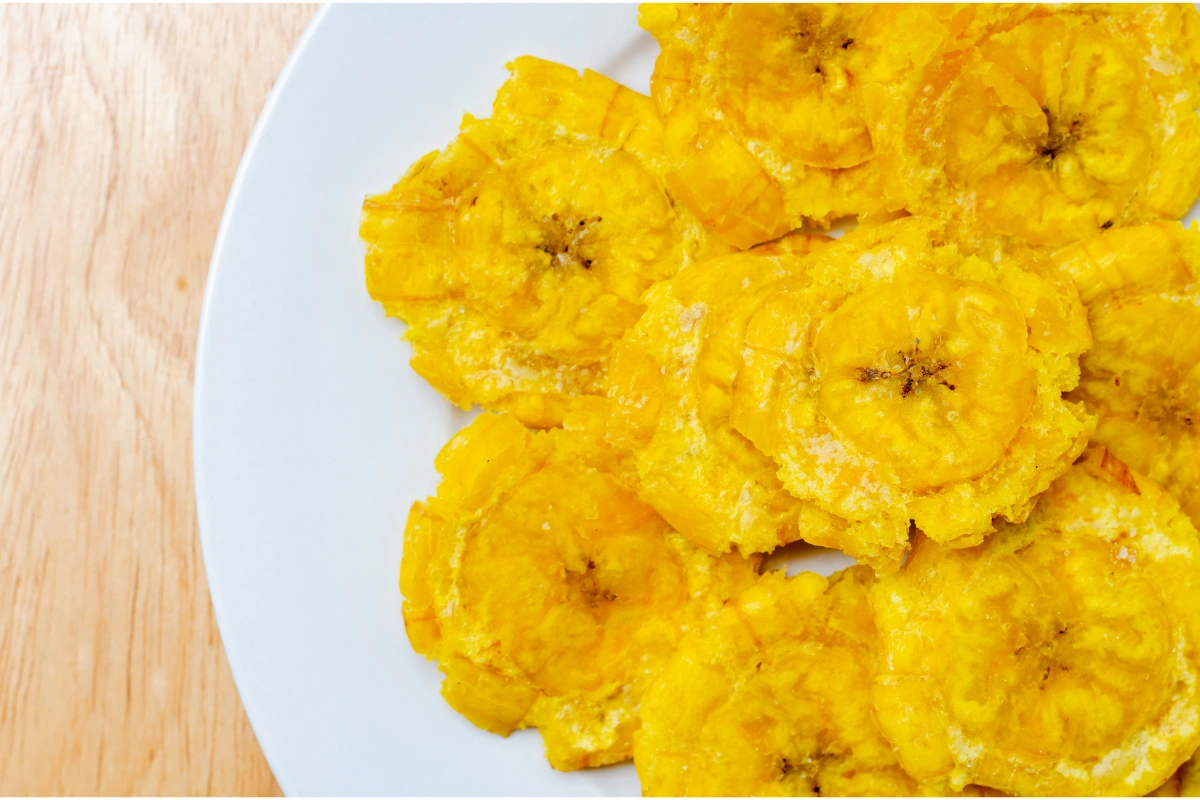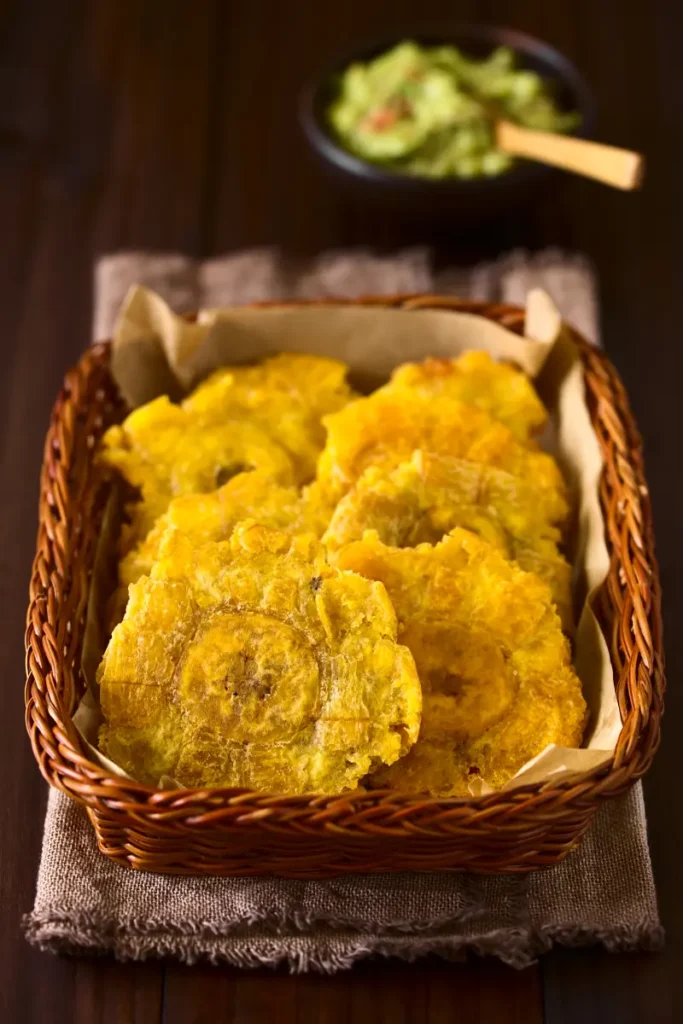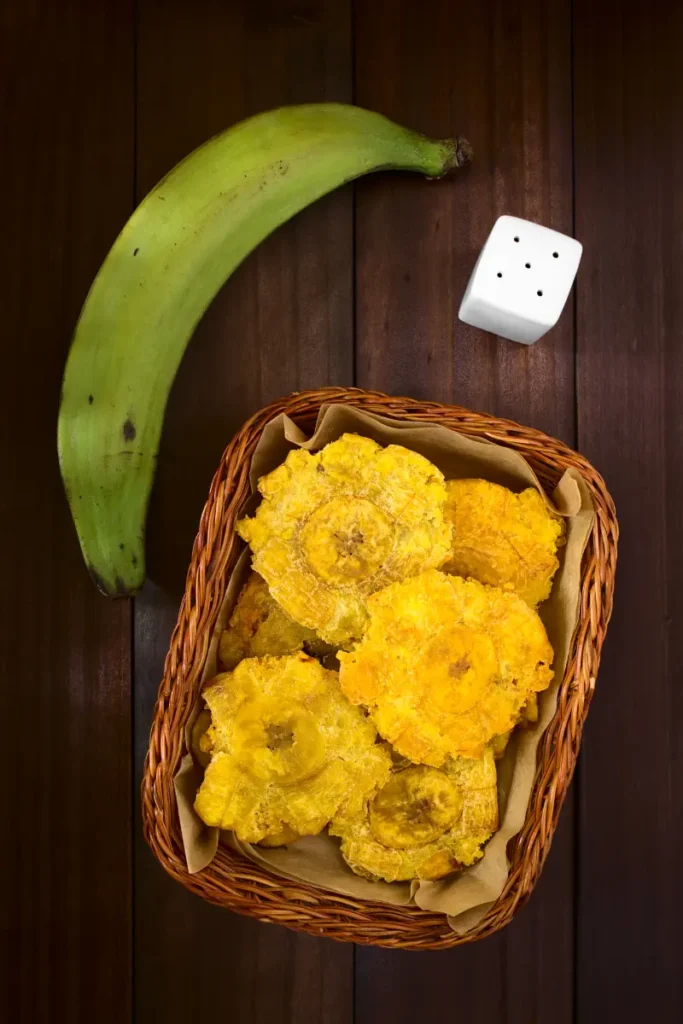Get ready to embark on a culinary adventure as we delve into the delightful world of patacones! These crispy, golden treats, also known as tostones, are a staple in many Latin American and Caribbean cuisines. From their humble origins to their versatile role in modern gastronomy, we’ll explore everything you need to know about patacones. So, grab a plantain, and let’s get started!
Introduction to Patacones
What are Patacones?
Patacones are twice-fried plantain slices that have captured the hearts (and stomachs) of people worldwide. These savory delights originated in Latin America and have become an integral part of the culinary landscape in countries like Colombia, Ecuador, Venezuela, and many others.
The key ingredient, of course, is the plantain. Unlike their sweeter banana cousins, plantains are starchy and require cooking before consumption. Green plantains, specifically, are the stars of the patacones show. Their firm texture and neutral flavor make them the perfect canvas for creating crispy, savory bites.
The basic preparation method involves slicing green plantains, frying them once, flattening them, and then frying them again until golden brown and irresistibly crunchy. However, just like any beloved dish, patacones boast regional variations in name and preparation. For instance, in some parts of the Caribbean, they’re known as tostones, while in Cuba, they might be called chatinos.
No matter the name or subtle differences in the recipe, one thing remains constant: patacones are a delicious and versatile treat enjoyed by people from all walks of life.
Making the Perfect Patacones
Choosing the Right Plantains
The foundation for perfect patacones lies in selecting the right plantains. Green plantains are the go-to choice, as their starchy nature ensures a firm texture that holds up well during the frying process. Avoid plantains with black spots or cracks, as these indicate overripe fruit that will be too soft and sweet for patacones.
When selecting plantains at the store, look for ones that are firm to the touch with a vibrant green peel. They should feel heavy for their size, indicating a good starch content. Remember, green plantains are our friends here – the greener, the better!
Frying Techniques
The magic of patacones lies in the double frying technique. This process ensures the perfect balance of a crispy exterior and a tender interior.
First, heat a generous amount of oil in a deep pan or fryer. Vegetable oil, canola oil, or peanut oil work well for this purpose. Aim for an oil temperature around 350-375°F (175-190°C) – hot enough to cook the plantains through but not so hot that they burn quickly.
Slice the plantains into 1-inch thick pieces and carefully add them to the hot oil. Fry them for about 2-3 minutes per side, or until they turn a light golden color. Don’t overcrowd the pan, as this can lower the oil temperature and result in soggy patacones.
Shaping and Seasoning
Once the plantains are par-cooked, it’s time to flatten them. Traditionally, a pataconera – a wooden tool specifically designed for this purpose – is used. However, if you don’t have a pataconera, don’t worry! You can use a tortilla press, the bottom of a heavy glass, or even a plate to flatten the plantain slices.
After flattening, season the patacones generously with salt. Some people also like to add a sprinkle of garlic powder or paprika for extra flavor. Now, it’s time for the second fry! Return the flattened patacones to the hot oil and fry for an additional 1-2 minutes per side, or until they achieve a deep golden brown color and a satisfyingly crisp texture.
Serving and Enjoying Patacones
Popular Toppings and Dips
Patacones are incredibly versatile and can be enjoyed with a wide array of toppings and dips. The classic accompaniment is hogao, a flavorful Colombian sauce made with tomatoes, onions, garlic, and spices. Its vibrant taste and chunky texture complement the crispy patacones perfectly.
For those who love creamy toppings, guacamole is always a winner. The smooth avocado dip adds a refreshing contrast to the savory patacones. Sour cream and cheese are also popular choices, offering a touch of tanginess and richness.
Patacones can also be elevated to a main course by topping them with seafood, shredded beef, chicken, or pork. The possibilities are endless! For vegetarian and vegan options, consider toppings like black beans, roasted vegetables, or fresh salsa.
Patacones as a Side Dish or Main Course
Patacones shine as both a satisfying side dish and a star of the main course. They pair wonderfully with grilled meats, fish, and even hearty stews. Their neutral flavor profile makes them a perfect canvas for bolder flavors, while their satisfying crunch adds textural contrast to any meal.
Building a patacon-based meal is a fun and creative way to explore different flavor combinations. Start with a base of crispy patacones, then layer on your favorite toppings and sauces. From there, the sky’s the limit!
Patacones in Different Cuisines
While patacones are deeply rooted in Latin American cuisine, their popularity has transcended borders and found its way into kitchens worldwide. Each region adds its unique twist to the preparation and presentation of patacones, resulting in a delightful tapestry of flavors and culinary traditions.
In the Caribbean, you might find patacones served with jerk chicken or alongside a refreshing seafood ceviche. In coastal regions, they often accompany fresh fish dishes, while inland areas may pair them with hearty stews and roasted meats. The versatility of patacones allows them to adapt and shine in diverse culinary landscapes.
From traditional preparations to modern fusion dishes, patacones continue to evolve and inspire food lovers everywhere. Whether you enjoy them as a simple snack or as part of an elaborate meal, patacones are sure to tantalize your taste buds and leave you craving more.
Health and Nutritional Aspects
Nutritional Value of Plantains
Beyond their delicious taste and versatility, patacones offer some nutritional benefits thanks to their star ingredient: plantains. Plantains are a good source of dietary fiber, which aids digestion and promotes gut health. They also provide essential vitamins and minerals such as potassium, vitamin C, and magnesium.
Plantains are rich in complex carbohydrates, making them a good source of energy. This is particularly beneficial for those with active lifestyles or individuals who need sustained energy throughout the day. However, it’s important to note that patacones are typically deep-fried, which increases their fat and calorie content. Moderation is key when enjoying these tasty treats.
Considerations for Dietary Restrictions
Individuals with dietary restrictions can still enjoy patacones with a few modifications. For those following a gluten-free diet, patacones are naturally gluten-free as long as they are not cross-contaminated with wheat-based ingredients during preparation.
Vegans can also indulge in patacones by choosing plant-based toppings and dips. Avocado-based dips, black beans, and fresh salsas are all excellent options. Just be sure to check the ingredients of any pre-made sauces or dips to ensure they align with your dietary needs.
It’s important to be mindful of the oil and sodium content of patacones, especially if you are watching your fat or salt intake. Opting for healthier oils, such as avocado or olive oil, and using a moderate amount of salt can help make patacones a more health-conscious choice.
Exploring the World of Plantains
Beyond Patacones: Other Plantain Delights
While patacones are undoubtedly a star of the plantain world, there’s a whole universe of culinary delights to explore with this versatile fruit. From sweet to savory, plantains offer a range of flavors and textures that can be enjoyed in numerous ways.
- Maduros: Ripe plantains, with their natural sweetness and softer texture, are often fried to create maduros. These caramelized treats are a popular dessert or snack in many Latin American countries.
- Mofongo: A Puerto Rican dish where fried green plantains are mashed with garlic, olive oil, and often pork cracklings, creating a flavorful and hearty side dish or main course.
- Plantain Chips: Thinly sliced and deep-fried to crispy perfection, plantain chips are a popular snack enjoyed around the world. They come in various flavors, from salted to sweet and spicy.
- Plantain Bread: A moist and flavorful bread made with mashed ripe plantains, offering a delightful twist on traditional banana bread.
- Boiled Plantains: A simple yet satisfying way to enjoy plantains, boiled plantains are often served as a side dish alongside savory meals.
The versatility of plantains extends beyond these examples, with countless recipes and culinary traditions showcasing their unique qualities. So next time you encounter plantains at the market, let your imagination run wild and explore the endless possibilities of this remarkable fruit.
FAQs about Patacones
What are patacones made of?
Patacones are primarily made from green plantains, which are starchy and less sweet than ripe bananas. They are sliced, fried, flattened, and then fried again until crispy and golden brown.
What is the difference between patacones and tostones?
“Patacones” and “tostones” are often used interchangeably to refer to twice-fried plantain slices. However, there might be subtle regional differences in thickness or preparation methods. Generally, both terms describe the same delicious treat.
What countries say patacones?
Patacones, or their regional variations like tostones, are popular in many Latin American and Caribbean countries, including:
- Colombia
- Ecuador
- Venezuela
- Panama
- Costa Rica
- Nicaragua
- Puerto Rico
- Dominican Republic
- Cuba
- And many more!
Are patacones healthy?
Patacones offer some nutritional benefits thanks to the fiber, vitamins, and minerals found in plantains. However, they are typically deep-fried, which increases their fat and calorie content. Moderation is key when enjoying patacones as part of a balanced diet.
What is the difference between tostones and patacones?
The terms “tostones” and “patacones” are often used interchangeably, and the distinction between them can be a bit blurry. Generally, both terms refer to twice-fried plantain slices. However, there might be subtle differences in preparation or thickness depending on the region.
For example, in some areas, “tostones” may refer to thinner, crispier plantain slices, while “patacones” might be thicker and slightly softer in the center. Ultimately, the names are regional variations of the same delicious treat.
Can I bake patacones instead of frying?
While frying is the traditional method for making patacones, baking can be a healthier alternative. To bake patacones, preheat your oven to 400°F (200°C). Follow the same steps for preparing the plantains as you would for frying, then place them on a baking sheet lined with parchment paper.
Bake for about 15-20 minutes per side or until golden brown and slightly crispy. Keep in mind that baked patacones will have a different texture than their fried counterparts – they will be less crispy and more tender.
How do I store leftover patacones?
To maintain the crispness of leftover patacones, store them in an airtight container at room temperature. Avoid storing them in the refrigerator, as this can make them soggy.
When you’re ready to enjoy them again, you can reheat patacones in a toaster oven or under the broiler for a few minutes until they are warmed through and regain their crispness. Explore different varieties of plantains and discover the unique characteristics of each type to find the perfect one for your patacones.
Conclusion
The Versatility and Appeal of Patacones
From their humble origins as a simple dish made with green plantains to their widespread popularity in various cuisines, patacones have come a long way. Their versatility shines through in the countless ways they can be enjoyed, whether as a snack, a side dish, or the foundation for a complete meal.
The cultural significance of patacones cannot be overstated. They represent a culinary tradition that has been passed down through generations, connecting people to their heritage and bringing communities together over shared meals.
So, whether you’re a seasoned patacones enthusiast or a curious newcomer, we encourage you to embrace the delicious world of these crispy plantain delights. Try making them at home, experiment with different toppings, and discover your favorite ways to savor this culinary treasure.
More Delicious Recipes:
- Mini pumpkin pies: Discover the charm of fall with our bite-sized Mini Pumpkin Pies. Each one is a burst of creamy, spiced pumpkin flavor, perfect for any gathering or a cozy night in. Click for the recipe and make your kitchen smell like autumn!
- Caldo de res: Embrace the warmth of traditional Caldo de Res, a hearty and flavorful Mexican beef soup. With tender beef and a rich mix of vegetables, it’s the ultimate comfort food. Click to find out how to bring this comforting dish to your table.




1 thought on “Patacones: A Delicious Guide to Crispy Fried Plantains”